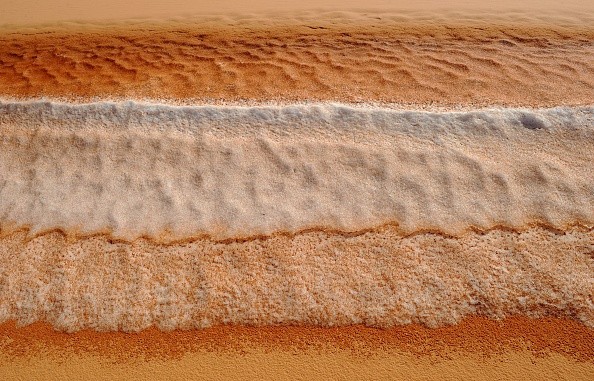Colorful images recorded by a drone in Shanshan County, northwestern China, around 1,550 miles west of Beijing, have been making waves since they were posted online. A number of languages translate "Kumtag" as "sand mountain" to describe the region's diverse collection of sand dunes.

Snowfall in Kumtag Desert
On February 26, the Kumtag's terrain was covered in melting snow, revealing the sand dunes. Due to how the white snow gives way to the striped desert sand, this particular vista looks like the fur of a tiger, as per AccuWeather.
According to AccuWeather Senior Commodity Meteorologist Dale Mohler, Snowfall sculpted by wind and sand dunes created a tiger-striped pattern in the Kumtag desert. The tan-colored sand beneath the snow-covered dunes was revealed as the wind pushed snow off the dunes' top, filling in the areas on the downwind portion of the dunes.
However, this does indicate that Mother Nature can be quite an artist, even if there is little to work with, Mohler said of the snowfall and wind speed.
Experts at AccuWeather.com estimate less than five inches of rainfall on the Kumtag region of southern Japan per year; however, low freezing temperatures allow snow to remain on the ground for longer.
Given its location near Pennsylvania's latitude, the Kumtag experiences snow during the winter months, as does that state. There are temperatures below 0 degrees Fahrenheit in the winter in this portion of the Taklamakan Desert. In fact, this is not Kumtag's first encounter with such a strange environment. During the month of November, the area was covered in snow.
Also Read : US Weather Forecast Warns Pair of Winter Storms to Affect Central US and Eastern US from Late This Week
Which System Brought the Snow?
There is a good chance that the storm that dropped the snow was almost the same as clippers, which are dry storms that originate in western Canada and may drop light snow across parts of the northern United States.
Weatherman Jim Andrews with AccuWeather says the snow likely fell on Feb. 17 near Ürümqi, China, roughly 170 miles northwest of the desert, when the morning low was 17 and the high temperature was 22.
The week's chilly weather allowed the snow to remain in place, creating a stunning display, according to Yahoo News.
Deserts Threatened by Climate Change
Scientists are still very unsure of snow in the desert. In part, this is due to a lack of historical data, as well as a lack of attention paid to the Sahara, a sparsely populated area.
Sahara's vastness (9 million square kilometers) and isolation are two of its most distinguishing features. It is now possible to map rainfall and snowfall patterns using satellite remote sensing data rather than traditional field observations. However, this only applies to the previous few decades; before the 1970s, there is no evidence of snowfall patterns.
So it appears that Saharan snowfall is more prevalent than previously thought. An anthropological and oral history investigation of this option would be intriguing. As a result of global climate change, however, weather patterns are becoming more unpredictable.
If this happens, the Sahara's wetter Sahelian border and its Atlantic and Mediterranean coasts, where rainfall is more variable, may see increasing rainfall variability (including in the Atlas Mountains).
Related Article : Snow Falls in Sahara Desert for the Second Time in Human History
For more news, updates about snowfall and similar topics don't forget to follow Nature World News!
© 2025 NatureWorldNews.com All rights reserved. Do not reproduce without permission.





